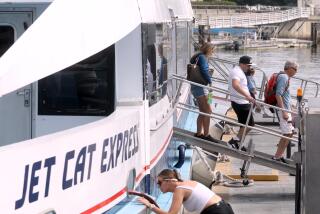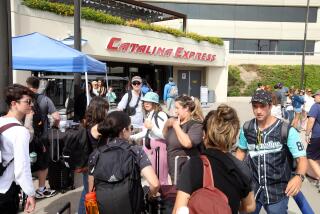Moving day not all smooth sailing
A massive tractor-trailer whined in first gear Friday as it pulled a 48-ton house off a barge and onto a remote Santa Catalina Island pier, nearly completing a herculean effort by movers who improvised to overcome tidal flows, equipment failures and other unexpected obstacles.
The 1,200-square-foot house was one of two that arrived on a barge at the USC Wrigley Institute for Environmental Studies near Two Harbors at daybreak after a six-hour ocean journey from a seaside construction site 22 miles away in San Pedro.
Institute authorities had hoped to have the custom-built houses with red tile roofs and vaulted ceilings in place on a scenic plateau by noon. Instead, Master House Movers’ crewmen spent most of the day devising pulley systems and steel ramps just to get the first house, which was connected to the tow bar of a 30-ton truck, off the barge.
The Tuscany-style house painted “ceremonial gold” hit pavement a day and a half behind schedule. But Tony Michaels, director of the institute, applauded and sighed, “What a relief! I’m elated just to see this thing actually moving.”
Then he started calling USC authorities on the mainland to share the good news. Michaels’ enthusiasm, however, was short-lived. After traveling about 100 yards at a pace of roughly a mile an hour, the wide load was stopped in its tracks by an obstacle somehow overlooked during earlier logistical sessions: two metal poles about 4 inches wide and 3 feet tall.
The exhausted crewmen suggested calling it a day and catching a cruise vessel home. But Michaels pointed out that the house had to be moved at least another 15 feet forward because it was blocking the flight path for a helicopter pad, a critical component of the isolated center’s hyperbaric chamber, about 20 miles from Avalon.
In a quick solution, the poles were sawed off and the house was parked a few yards away.
That was only one setback in a series of frustrating delays in finishing the first phase of the new George and MaryLou Boone Center for Science and Environmental leadership, which will feature elegant lodging for world-class scientists who tend not to want to stay overnight in the facility’s existing dormitory rooms.
Each time things got dicey, Ted Hollinger, 73, owner of the moving company, brought work to a sudden halt by blowing hard on a metal whistle dangling from a cord around his neck.
The shrill command was heard above the din of heavy machinery throughout the day to signal myriad problems needing immediate attention. Hydraulic jacks beneath houses had to be repeatedly repositioned. Steel beams intended to break the fall if a house were to topple off its four eight-wheel dollies had to be secured with chains and ropes as thick as anacondas. Wheels got stuck in ruts on the deck of the barge.
Not surprisingly, tempers sometimes flared with bursts of salty exclamations as the day wore on.
At 6 p.m., the workers put their crowbars and sledgehammers away, propped the house up on hydraulic lifts in a “sleep mode” and left the barge with one house still on it tethered to the dock.
As a herd of deer watched the commotion from a nearby bluff, Hollinger, who has moved about 5,000 houses in his career, summed up the situation this way: “Not good. Nothing went right. But we’ll get it up the hill tomorrow, unless they don’t want me to.”
“Oh no,” Michaels added. “We desperately want them to.”
--
More to Read
Sign up for Essential California
The most important California stories and recommendations in your inbox every morning.
You may occasionally receive promotional content from the Los Angeles Times.











